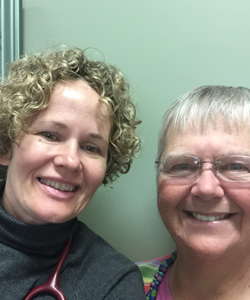Interdisciplinary Approach to Anticipatory Chronic Disease Management-Pharmacotherapy
Chronic Care and Patient-Centred Care

Judy Gillies
705-264-1881
Barbara Reid
705-221-7965
NOSM, Laurentian REB, Timmins FHT, Timmins-LEG
Highlights
Transformation:
Efficacious medication renewals; Poly-pharmacy risk reduction; Team based approach utilizing full scope of practice; Yearly review and update of health status/concerns, immunizations and screening of chronic disease indices(meet MOH targets);
Adoptability:
This anticipatory approach to promote preventive care and efficacious pharmacotherapy in Chronic Disease Management (CDM) is adoptable in any setting.
Outcomes:
- Reduced renewal calls – time and money savings
- Update of medical records
- Improved self-efficacy of patients/caregivers with collaborative team support – focus on patient education and self-care.
- Improved satisfaction of interdisciplinary team -health care team utilized to their full scope of practice with increased PCP availibility for acute/urgent care.
Abstract
Poly-pharmacy is a hallmark of CDM. CDM requires surveillance and periodic systematic review of the pharmacotherapy of individual patients to reduce undue side effects/interactions and to evaluate ongoing risk/benefit.
“Annual physicals” for all people is not seen as a means to ensure “high-quality care”. However, management of chronic disease/ongoing conditions, and the need to evaluate the effects of medications are seen as important aspects of preventive care.(www.choosingwiselycanada.org)
Over any 12 month period, numerous renewal requests are made by patients, caregivers, and pharmacy. Requests require time expenditure at each stage of the renewal process.
This demonstration project utilized the existing electronic medical record (EMR) and the interdisciplinary team(physician, nurses, NP, Pharmacists, clerical) to develop an Anticipatory Approach to Pharmacotherapy in CDM. The cohort of patients for this 2 year study, were those (i) age 65 and over on 5 or more prescription medications; and (ii) those with chronic non-cancer pain (any age), from a single physician practice, in a multidisciplinary FHT setting.
The yearly review (Proactive Annual Health Review) was conducted within the month of the patients birthdate, to ensure that the EMR was current, that Ministry preventive health strategies were up-to-date, and that individualized profiles (vitals, ht/wt, blood work, medication reconciliation, etc) were updated.
Prior to initiation of the study intervention office calls (n=128) ranged from 1 to 14/patient. In the first 6 months of the Year 2 followup, the same patient cohort (n=44) had on average, less than 1 call (n=31) per patient. MedsChecks conducted by community pharmacies reduced the time burden of the PAHR in office.
Outcomes – Study conclusion Aug 2016- see Highlights above.

 Judy Gillies" class="rev-slidebg tp-rs-img" data-no-retina>
Judy Gillies" class="rev-slidebg tp-rs-img" data-no-retina>